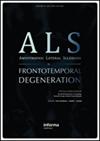Is firstly diagnosed ALS really ALS? Results of a population-based study with long-term follow-up
IF 2.8
4区 医学
Q2 CLINICAL NEUROLOGY
Amyotrophic Lateral Sclerosis and Frontotemporal Degeneration
Pub Date : 2017-04-03
DOI:10.1080/21678421.2016.1249886
引用次数: 4
Abstract
Abstract Objective: To revise the first diagnosis of amyotrophic lateral sclerosis (ALS) in patients from a well-defined population. Methods: Patients diagnosed with ALS in the years 1998-2002 and resident of Lombardy Region, Northern Italy were followed until death or April 30 2016 to assess long-term survival. During follow-up, the caring neurologists were asked to confirm the first diagnosis. Revised diagnoses were classified as confirmed and unconfirmed motor neuron disease (MND) with further specification where available. The two groups were compared for age, sex, disease duration at diagnosis, site of onset, and El Escorial category. Survival with predictors were also compared. Results: Included were 280 men and 203 women aged 18-93 years. During follow-up, 25 cases (5.2%) received a diagnosis different from MND. Diseases of spinal roots and peripheral nerves and vascular encephalopathy predominated. Patients with definite (OR 0.15; 95%CI 0.04-0.52) and probable (OR 0.15; 95%CI 0.04-0.62) ALS were least likely to have an unconfirmed MND diagnosis. At end of follow-up, 2.2% of patients with confirmed MND and 44.0% of patients with unconfirmed MND were reported alive (HR 0.14; 95%CI 0.08-0.25). Conclusions: At the time of a first diagnosis of ALS, the possibility still exists that another, less severe clinical condition, is present.首次诊断的ALS真的是ALS吗?一项基于人群的长期随访研究结果
【摘要】目的:对明确人群中肌萎缩性侧索硬化症(ALS)的首次诊断进行修正。方法:对1998-2002年诊断为ALS的意大利北部伦巴第地区居民进行随访,直至死亡或2016年4月30日评估长期生存率。在随访期间,护理神经科医生被要求确认首次诊断。修订后的诊断分为确诊和未确诊的运动神经元疾病(MND),并提供进一步的说明。比较两组患者的年龄、性别、诊断时病程、发病部位和El Escorial分类。生存率与预测指标也进行了比较。结果:纳入男性280人,女性203人,年龄18 ~ 93岁。在随访中,25例(5.2%)的诊断与MND不同。脊髓根、周围神经疾病和血管性脑病占主导地位。明确(OR 0.15;95%CI 0.04-0.52)和probable (OR 0.15;(95%CI 0.04-0.62) ALS患者最不可能有未确诊的MND诊断。随访结束时,2.2%确诊MND患者和44.0%未确诊MND患者报告存活(HR 0.14;95%可信区间0.08 - -0.25)。结论:在首次诊断ALS时,仍然存在另一种不太严重的临床症状存在的可能性。
本文章由计算机程序翻译,如有差异,请以英文原文为准。
求助全文
约1分钟内获得全文
求助全文
来源期刊

Amyotrophic Lateral Sclerosis and Frontotemporal Degeneration
CLINICAL NEUROLOGY-
CiteScore
5.40
自引率
10.70%
发文量
64
期刊介绍:
Amyotrophic Lateral Sclerosis and Frontotemporal Degeneration is an exciting new initiative. It represents a timely expansion of the journal Amyotrophic Lateral Sclerosis in response to the clinical, imaging pathological and genetic overlap between ALS and frontotemporal dementia. The expanded journal provides outstanding coverage of research in a wide range of issues related to motor neuron diseases, especially ALS (Lou Gehrig’s disease) and cognitive decline associated with frontotemporal degeneration. The journal also covers related disorders of the neuroaxis when relevant to these core conditions.
 求助内容:
求助内容: 应助结果提醒方式:
应助结果提醒方式:


